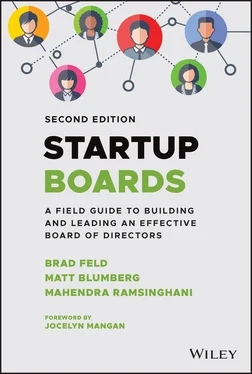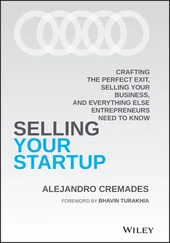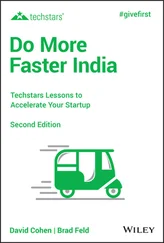Brad Feld - Startup Boards
Здесь есть возможность читать онлайн «Brad Feld - Startup Boards» — ознакомительный отрывок электронной книги совершенно бесплатно, а после прочтения отрывка купить полную версию. В некоторых случаях можно слушать аудио, скачать через торрент в формате fb2 и присутствует краткое содержание. Жанр: unrecognised, на английском языке. Описание произведения, (предисловие) а так же отзывы посетителей доступны на портале библиотеки ЛибКат.
- Название:Startup Boards
- Автор:
- Жанр:
- Год:неизвестен
- ISBN:нет данных
- Рейтинг книги:3 / 5. Голосов: 1
-
Избранное:Добавить в избранное
- Отзывы:
-
Ваша оценка:
- 60
- 1
- 2
- 3
- 4
- 5
Startup Boards: краткое содержание, описание и аннотация
Предлагаем к чтению аннотацию, описание, краткое содержание или предисловие (зависит от того, что написал сам автор книги «Startup Boards»). Если вы не нашли необходимую информацию о книге — напишите в комментариях, мы постараемся отыскать её.
Startup Boards: A Field Guide to Building and Leading an Effective Board of Directors
Startup Boards
Startup Boards — читать онлайн ознакомительный отрывок
Ниже представлен текст книги, разбитый по страницам. Система сохранения места последней прочитанной страницы, позволяет с удобством читать онлайн бесплатно книгу «Startup Boards», без необходимости каждый раз заново искать на чём Вы остановились. Поставьте закладку, и сможете в любой момент перейти на страницу, на которой закончили чтение.
Интервал:
Закладка:
The word boardroom conjures up images of important people puffing on cigars or sipping Scotch while sitting in leather chairs in wood-paneled rooms. They talk about complex things that determine the company's future. Formality and seriousness fill the air. Big decisions are being made.
While first-time CEOs and founders often have an elevated view of the boardroom, great startup boards aren't fancy, complex, or pretentious. Instead, a startup board is usually a small group of people trying to help build your company.
We've served on hundreds of boards. A few were great, many were good, and some were terrible. When things were going smoothly, the board was congratulatory and supportive. When there were challenges, some board members helped, others panicked, and a few vanished. The tempo and interactions of these boards varied dramatically. In some cases, reality dominated the discussion, while often, it was ignored or denied.
After a particularly tedious board meeting, Brad realized that a startup board's default structure, composition, and approach were an artifact of the past, dating to how early venture-backed company boards operated over 40 years ago. Things had changed and evolved, but the dramatic shift in communication patterns and technology hadn't been incorporated into how most boards worked. As a result, Brad ran a two-year experiment where he tried different things—some successful, some not. As with every experiment, he did more of what worked, modified and killed what didn't, tried new things, and measured a lot of stuff.
The idea for the first edition of this book emerged during this experiment. We decided that in addition to describing the new startup board approach that resulted from Brad's experiment, it was essential to lay the groundwork and clearly explain how startup boards worked and how they could be most effective. Brad's board approach builds upon the traditional board of directors, so rather than throw it out, we use a highly functioning one as the basis for a new and more effective approach to a board of directors.
While the topic may feel dry, we've tried, as Brad and Jason Mendelson did in Venture Deals: Be Smarter Than Your Lawyer and Venture Capitalist (2019), to take a serious topic and cover it rigorously in plain English with our brand of humor. Our aim is to demystify how a board of directors works, discuss best and worst practices, and provide a set of tools for creating and managing an awesome board.
Unless you've been a startup executive who regularly attended board meetings and interacted with board members, you probably don't know what a startup board looks like, how it functions, or how it impacts a company. Even if you're a founder, you may never have served on a board of directors before, let alone built and managed one. Early in their careers, even venture capitalists often have little board experience.
You may envision a board as a collection of faceless notables, convening meetings around a large conference room table with agendas packed with legalese about corporate governance. You might view the board as a boys' club full of older men either telling the CEO what to do or supporting whatever the CEO wants because they are in the CEO's pocket while enjoying expensive board dinners and periodic boondoggles to exotic locations.
We wrote this book to dispel these myths, demystify the workings of a board, help you understand how to create and build your board while sharing our decades of experience about leveraging your board so it becomes a strategic asset for you and your company.
What's New in the Second Edition
Brad and Mahendra have collaborated with Matt Blumberg on this edition. You met Matt in the Preface, and we quoted him several times from his book Startup CEO (Blumberg, 2020) in the first edition of this book.
It's been almost a decade since we first wrote this book. Since then, a Cambrian explosion of entrepreneurial activity has occurred worldwide. We've helped democratize entrepreneurship globally through Techstars, our investments, organizations building startup communities in many different cities, and our writing. While Brad updated several of his earlier books, such as Venture Deals and Startup Communities: Building an Entrepreneurial Ecosystem in Your City (Feld, 2020), the original version of Startup Boards was starting to feel stale.
After completing Startup CXO , Matt reached out to Brad and Mahendra with ideas on revising and updating Startup Boards . Matt's newest company, Bolster, took over the Startup Revolution series of books and startuprev.com. Brad and Matt have served together on four boards over the past 20 years, including Matt's company (Return Path), two boards where Brad was an investor and Matt was an independent director (FeedBurner and Moz), and one non-profit that Matt co-founded and where Brad served as an independent director (Path Forward). This shared experience made it easy to collaborate on the second edition.
We've updated the content from the first edition and added more depth for first-time founders about how to build a board, recruit board members, and onboard, compensate, and evaluate them. We've added content for aspiring board directors about identifying board opportunities and preparing for their first board role. We'll extensively discuss recruiting board members, managing an advisory board, and communicating with a board. We've updated many of the book’s sections, bringing in relevant research, current best practices, guidance, and learning from the changes brought to boards by the COVID-19 pandemic.
When we wrote the first edition, we had a short section on board diversity with a primary focus on gender. Over the past decade, especially in the last few years, board diversity has become a major issue in entrepreneurship. Increasing board diversity is an important goal of many entrepreneurs, investors, and entrepreneurial support organizations. This edition addresses how startups can increase board diversity and the tangible benefits of board diversity to a company.
We've added quantitative data on key startup board characteristics. Bolster created a first-of-its-kind Board Benchmark Survey as part of its larger offering of helping startups create boards. Until Bolster's survey, the actual demographics of a board—the composition, number of directors, compensation, length of service, and several other board characteristics—were largely unknown.
Who This Book Is For
We're deeply committed to entrepreneurship, having spent our entire careers starting, funding, and building companies while helping create entrepreneurial ecosystems worldwide. Our focus on entrepreneurship, along with the book's title, may lead you to think Startup Boards applies only to entrepreneurs and early-stage boards.
While startup boards do have specific issues and challenges, there are far more similarities than differences. The leader of any type of organization with a board, including a larger private company, non-profit, public company, community organization, or family-owned business, will find many useful ideas in this book.
Our primary audience is founders, entrepreneurs, or non-founder CEOs. However, this book also addresses anyone on a board, including investors and outside directors. We've worked with thousands of board members, covering a wide range of experiences, challenges, and problems. While some of these board members were spectacular and had a dramatic positive impact on the trajectory and outcome of a company, many were average and had a neutral or insignificant impact. Others were detrimental, causing more problems that negatively impacted the company and the board's functioning. We've learned extensively from these experiences, which we've tried to incorporate into this book in a way that's helpful to any board member.
Читать дальшеИнтервал:
Закладка:
Похожие книги на «Startup Boards»
Представляем Вашему вниманию похожие книги на «Startup Boards» списком для выбора. Мы отобрали схожую по названию и смыслу литературу в надежде предоставить читателям больше вариантов отыскать новые, интересные, ещё непрочитанные произведения.
Обсуждение, отзывы о книге «Startup Boards» и просто собственные мнения читателей. Оставьте ваши комментарии, напишите, что Вы думаете о произведении, его смысле или главных героях. Укажите что конкретно понравилось, а что нет, и почему Вы так считаете.












